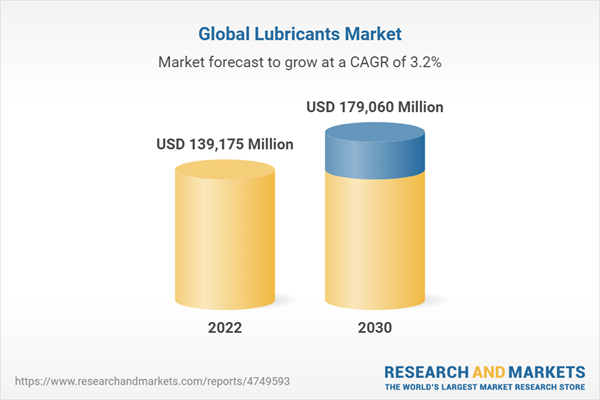
Global lubricants market

Dublin, March 06, 2023 (GLOBE NEWSWIRE) — The “Global Base Oil Lubricants Market Size and Share Analysis, Product Type, End User – Demand Forecast Forecast” report has been added. industry until 2030″ ResearchAndMarkets.com’s offers
The energy efficiency of industrial and automotive machinery increases significantly with lubricants. Internal combustion engines, winches, compressors, engines, gearboxes and other machinery on ocean-going vessels can perform better and last longer when lubricants are used.
According to the report, the lubricants market is expected to reach USD 179.06 billion by 2030. This is attributed to various factors, including the expansion of the automotive sector and other manufacturing sectors in developing countries such as Brazil, India, China and Mexico; the increase in process automation in various end-use industries; and the increase in the number of cars on the road.
The mineral oil category accounted for the largest share of revenue or more than 68%, and is expected to continue to hold this position throughout the projection period. This is attributed to the economical cost of raw materials, the simpler production method, the existence of more mineral oil manufacturers and its widespread use in many industries such as textile, automotive, industrial and construction.
But in the coming years, the synthetic oil sector will experience a major expansion. Due to its superior efficiency over mineral oils, this oil is increasingly preferred by customers. This increase can also be related to consumers having more cash available due to the increase in per capita income.
In addition, motor oil had the largest revenue share at around 32%, which will continue to dominate the market. Increasing public awareness of the benefits of using lubricants in your cars, especially their role in improving mileage and extending the life of automobiles, as well as the growing global transportation sector, are to blame for this
One of the main industries where lubricants are used is the automobile. To ensure the effective operation of vehicle engines, automotive lubricants are often used in crankcases. With its use, the friction of automobiles is reduced, extending its useful life and minimizing wear.
Due to rising disposable income and expanding consumer knowledge about the use of lubricants in cars, the need for heavy and light passenger vehicles is on the rise, which is a major factor in the rise in the use of lubricants in the automotive sector. Therefore, increased sales and vehicle manufacturing expands the market for lubricant producers.
Modern lubricants, including bio-based lubricants, are replacing older automotive lubricant materials to improve fuel economy and reduce harmful environmental consequences. The renewable and biodegradable ingredients used in bio-based oil and fats, such as fatty acids, are reacted with synthetic alcohols to produce esters.
In addition, government programs also encourage the use of these lubricants. For example, by establishing a labeling scheme to allow the marketing of bio-based goods and a priority procurement program for federal agencies and their contractors, the FSRIA, founded by the U.S. Department of Agriculture Together, it helps greater use and acquisition of biological products. based products.
Companies mentioned
-
PetroChina Company Limited
-
Chevron Corporation
-
Illinois Tool Works Inc.
-
BP plc
-
Shell plc
-
Petrochemical Corporation of China
-
Castrol Limited
-
Hindustan Petroleum Corporation Limited
-
Exxon Mobil Corporation
-
TotalEnergies SE
-
FUCHS PETROLUB SE
-
Amsoil Inc.
-
Motul
-
Buhmwoo Chemical Co. Ltd.
-
Repsol S.A
Report metrics:
|
Report attribute |
Details |
|
Number of pages |
180 |
|
Forecast period |
2022-2030 |
|
Estimated market value (USD) in 2022 |
139175 million dollars |
|
Projected market value (USD) for 2030 |
179060 million dollars |
|
Compound annual growth rate |
3.2% |
|
Regions covered |
global |
Key topics covered:
Chapter 1. Scope of the research
Chapter 2. Research methodology
Chapter 3. Executive summary
Chapter 4. Voice of Industry Experts/KOLs
Chapter 5. Market indicators
Chapter 6. Sector perspectives
6.1. Market dynamics
6.1.1. trends
6.1.2. drivers
6.1.3. Limitations/challenges
6.1.4. Impact analysis of drivers/constraints
6.2. Impact of COVID-19
6.3. Analysis of Porter’s five forces
Chapter 7. Global market
7.1. Overview
7.2. Market volume, by base oil (2017-2030)
7.3. Market revenue, by base oil (2017-2030)
7.4. Market volume, by product type (2017-2030)
7.5. Market revenue, by product type (2017-2030)
7.6. Market revenue, by end user (2017-2030)
7.7. Market volume, by region (2017-2030)
7.8. Market revenue, by region (2017-2030)
Chapter 8. North America Market
Chapter 9. European market
Chapter 10. APAC Market
Chapter 11. LATAM market
Chapter 12. MEA market
Chapter 13. Competitive landscape
13.1. List of market players and their offers
13.2. Competitive benchmarking of key players
13.3. Product benchmarking of key players
13.4. Recent strategic developments
Chapter 14. Company profiles
Chapter 15. Appendix
For more information on this report, visit https://www.researchandmarkets.com/r/m4gyku
About ResearchAndMarkets.com
ResearchAndMarkets.com is the world’s leading source of international market research reports and market data. We provide you with the latest data on international and regional markets, key industries, top companies, new products and the latest trends.
attachment
CONTACT: CONTACT: ResearchAndMarkets.com Laura Wood,Senior Press Manager press@researchandmarkets.com For E.S.T Office Hours Call 1-917-300-0470 For U.S./ CAN Toll Free Call 1-800-526-8630 For GMT Office Hours Call +353-1-416-8900



